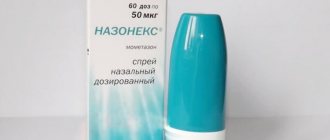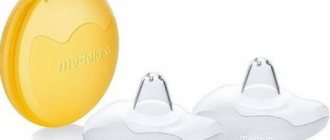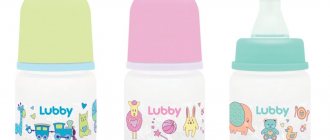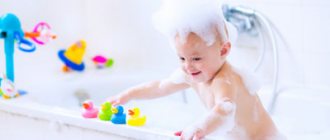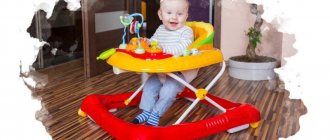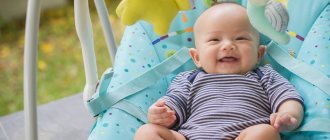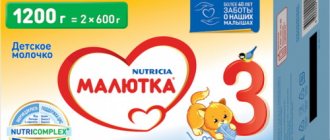A newborn baby brings a family a lot of joy and new experiences. Breastfeeding is a very beneficial process for the baby that brings pleasure to both participants. In addition, when mommy puts her baby to her breast, she helps establish a connection that is so necessary for the development and growth of the baby. But it happens that for some reason breastfeeding becomes difficult. This is due to either painful sensations or a weak sucking reflex of the baby. This is where breastfeeding nipple shields can help. Some mothers do not hesitate to use the term “salvation” when describing the unpleasant situations that have arisen and the way out of them at the moment when they began to use silicone pads for breastfeeding. However, experts voice several negative factors of using this attribute. In the article we will consider in detail all the pros and cons.
What are nipple shields?
Silicone breast shields for nursing are convex, nipple-like shapes made from a clear polymer. They differ slightly in design and material. But, in general, they are equally practical and easy to use. At the top of the pad there are holes through which the baby will suck the mother's milk. The wings of the pad (i.e. the parts that hold it on the chest) are soft and pleasant, the “nipple” itself is made of a slightly denser polymer.
What are pads needed for?
A). As a rule, nipple shields are used in non-standard situations so that the baby can receive full breastfeeding rather than expressed milk from a bottle.
Before the baby arrives, the shape of a woman’s nipples is unlikely to give rise to additional concerns. But, once in the maternity hospital, sometimes you have to come to terms with the fact that the nipple is not convex (large/compact) enough. Moreover, “not enough” refers only to the peculiarities of eating by your baby. And probably only in the first days. Even those mothers who regularly attend “motherhood school” and prepare their nipples for constant exposure are not immune to the fact that this part of the breast (being the most sensitive) can become irritated or cracked. You can rub your breasts with a terry towel (the “old-fashioned” method, which modern doctors advise to completely eliminate when preparing nipples for feeding), but still, every time you put your baby to your breast, you experience pain and impatiently wait for the minute when the baby is full.
Let's look at special cases in which breast pads are used for feeding.
— First of all, when cracks occur in the nipples. Almost every woman faces this. But everyone's pain threshold is different. And if someone practically does not feel pain, then for some, these sensations are not tolerable. The covers will protect the nipple from the touch of the tongue and large amounts of baby saliva. When the nipples heal and become immune to irritation, the need for nipple shields is no longer necessary.
- The baby may have a weak sucking reflex. There is a possibility that he may constantly “drop” the breast or try to “twist” the nipple. Such situations are usually a consequence of birth trauma or delayed fetal development. Or simply an individual characteristic of the child. If your baby is weak and finds it difficult to breastfeed, seek help from a modern remedy. When using shields, the newborn will not be able to push out the nipple with his tongue and it will be much easier for him to access mother's milk.
— If a woman’s nipple is flat and her breasts are dense, then even a strong and healthy baby may find it difficult to wrap his mouth around the desired part of the areola. In this case, you can use a shield as a temporary means to shape the nipple into a shape that is comfortable for the baby.
There is an opinion among experts that breast shields do not promote nipple formation and do not relieve pain, but many mothers, using the product in practice, report exactly the opposite results.
— You can use breast pads during feeding, even when the baby is teething. At such moments, the baby may be capricious, so he will grab the nipple more dynamically, which can cause pain to the mother. The first few days after the gums begin to swell, you can use soft pads to avoid wounds and chafing on the areola of the breast.
From all of the above, it should be concluded that you should feed your baby using silicone nipple covers only if there is a need. If possible (if the reason that prevents you from feeding the child in the usual way disappears), they should be gradually abandoned.
B). Protective nipple covers can be worn at home to protect against contact with underwear, since there is space between the convex part of the cover and the nipple and protects it from interaction with both the polymer and the fabric. If microcracks appear on the chest and wearing a bra hurts, then this method is completely justified for a short time. But, do not forget that in this case, air access to the nipples is limited, and healing slows down. Also remember that after wearing the pads under your underwear, the holes may become clogged with fabric lint. In this case, the pads must be cleaned and sterilized.
All about breast pads for breastfeeding
Breast pads for feeding are special latex or silicone products, the purpose of which is to facilitate the process of breastfeeding.
Unfortunately, the unjustified use of breastfeeding often not only does not solve the existing problem, but also gives rise to certain disruptions in the entire breastfeeding process.
When is it acceptable to use breast pads?
- Formation of lactation. Breastfeeding can be quite painful at first. The main mistake is incorrect attachment to the breast, as a result of which the baby sucks “in vain”, causing discomfort.
- The baby refuses his mother's breast. If a mother has been expressing milk for a long time and giving it to the baby from a bottle, then the baby will begin to prefer the bottle, because eating milk from a bottle is much easier than from the mother’s breast: in order to get milk, you need to make a lot more effort than during a meal from a bottle. Nipple shields are similar in shape and rigidity to a bottle nipple, so when transitioning from a bottle to breastfeeding, the use of shields may be advisable (read about how to wean your baby to the breast after a bottle).
- Cracked nipples , accompanied by unbearable pain when feeding (About cracked nipples and how to feed).
- Severe birth injuries , leading to delayed development of the child’s nervous system, are the cause of sluggish or improper sucking. In this case, breast pads are used to teach sucking.
- Premature, weakened children do not have enough strength to suck milk during the first time after birth. Because of this, insufficient emptying of the breast and malnutrition (weight loss) occurs in the child.
- Teething. During the teething period, children are especially capricious and restless, and try to “scratch” their gums with any object, including their mother’s nipple. Babies often bite their breasts during feeding, which is undoubtedly very unpleasant and painful. Breast shields for feeding sometimes help to save nipples from bites.
- Anomalies in the structure of the nipple: flat, inverted or too large nipple.
- Anomalies in the structure of the oral cavity in a child - a shortened frenulum.
It is important to note that the use of breastfeeding shields is always a last resort in solving any of the above problems.
Modern doctors recommend using pads only in exceptional cases and under the systematic supervision of a breastfeeding specialist. Only if other techniques for breastfeeding are ineffective, it is possible to use nipple shields as a short-term aid (here we wrote why lactation consultants are often against breast shields) .
A very useful article with a lot of videos: How to properly attach a baby to the breast
What can be the consequences of using breastfeeding pads?
[sc:rsa]
- Several studies have found results that are not in favor of pads, with milk production being reduced by about half. This is due to the fact that the pads disrupt the psychological contact “mother-child”. Because of this, the release of oxytocin, a pleasure hormone that relaxes the milk ducts and affects milk production, is disrupted;
- Even the thinnest silicone nipple covers disrupt the sucking mechanism when used for a long time. The baby begins to suck faster and more intensely, causing the pauses to become longer. Such sucking is characteristic of the stage of fading lactation. The sucking technique is disrupted: the child clenches his jaws more strongly (chews the breast), sucks in a “vacuum” way;
- With the pad, feeding takes longer. Milk leaks under it and the child does not get enough to eat. Also, in order to get the portion of milk necessary for saturation, when using breast pads for feeding, the baby stays at the mother’s breast longer than expected. Some babies get so tired from sucking that they fall asleep half-starved, as a result of which they often lose weight;
- When sucking with a pad, the baby swallows air more often , which leads to increased flatulence, colic, and regurgitation;
- Inconvenient to use at night or on the street when walking;
- If insufficiently sterilized, covers can become a source of infection of the nipple. Women who use breast pads for a long time are more likely to develop breast candidiasis;
- With prolonged use of the pads, the child and mother become accustomed to them.
Pros and cons of using
It is worth noting that any “helper” (and nipple covers are no exception) has positive and negative aspects of use.
What is the advantage of a modern tool?
— The pads help the baby learn to suckle at the breast if any reasons have caused the separation of mother and baby in the first days (weeks) of the child’s life. Most often this is an intensive care unit or a quarantine unit. The baby is already accustomed to the nipple, and the mother’s nipple seems unnatural to him. The overlay will allow you to gradually “explain” to your baby the need to eat without additional funds.
— With the help of protective pads you can “stretch” and maintain the shape of the nipple during feeding. As a rule, the baby takes pauses, during which the flat nipple (without using a shield) can return to its original shape, and the baby again has to “suck” it into the mouth. If he is almost full, he may be lazy and not drink enough milk.
— If you use pads from the very beginning of feeding, then there is a chance of preventing the appearance of microcracks and irritation. When a mother’s child is not her first and she knows that her breasts are sensitive to the process of natural feeding, then you can use polymer pads from the very first days and gradually “wean off” them. In this way, nipple injuries can be prevented. It's easier than treating cracks.
Why are nipple shields uncomfortable? How to use them so as not to experience the negative aspects of use?
— Overlays sometimes contribute to aggravation of the root cause of their use - they additionally injure the nipple if used incorrectly or if the size is incorrectly selected. If a nursing mother has problems with breasts and feeding, then it is better to contact a specialist and find out about ALL ways to solve the problem.
- Sometimes when using pads there is a tendency to reduce milk supply. This happens because the areola and nipple are not stimulated enough. The child slowly gains weight and becomes accustomed to malnutrition. The breastfeeding process, in this case, may end prematurely.
“The baby sometimes gets so used to the breastplates that he categorically refuses to take the breast without them. The weaning process is very difficult and leads to irritability of mother and child.
There are also objective indicators of the use of overlays:
- if the nipple of the breast has an abnormal shape;
- in case of discrepancy between the sizes of the nipple and the child’s mouth (the mother has a large nipple, and the baby has a small mouth);
- the presence of birth injuries and developmental disorders of the central nervous system in the baby;
- transition from necessary artificial feeding to breastfeeding (for easy adaptation);
- with an abnormal structure of the child’s oral cavity.
How to wean your child off pads
According to breastfeeding consultants, the technique of eliminating pads is no less important in the instructions for use than their choice. It is important to remember that the less you use an accessory, the easier it will be to abandon it.
- Start feeding in the shield and quickly remove it as you go. A hungry baby may not notice the “substitution” and will calmly continue to eat;
- Offer your unprotected breast to your sleepy baby. The most convenient time to return to full-fledged natural feeding is the period of night sleep and after waking up. When your baby is sleeping, he is much more likely to latch onto your nipple;
- Reduce the area of silicone. Cut off a small piece from the silicone nipple every day, thereby increasing the area of contact between the baby and the body. Gradually abandon polymer molds completely;
If your baby is too attached to the shields and refuses to breastfeed without them, be patient. It may take you a couple of weeks to return to normal feeding.
- Spend more time with your baby. Carry him in your arms, sleep together. Constant contact with the mother and availability of the breast at any time of the day or night will allow the baby to quickly get used to it;
- Remove all breast fakes. It is necessary to get rid of everything that the baby can suck: pads, nipples. Gradually, the need to implement the sucking reflex will encourage him to “return to the chest”;
- Supplement with expressed milk. If your baby cries under your breast and refuses to eat, feed him your milk from a cup, pipette or spoon. Offer the breast before and after feeding.
Reviews from forums
I fed my son through the breastplate for about five months. I didn’t bother with sterilization, I just washed it thoroughly and doused it with boiling water. I heard for the first time that if you feed through a breastplate, the child does not gain weight. IMHO this is nonsense. Expressed milk from a bottle is ok, but the same milk from the breast through a breast shield is not possible?!?! This is some kind of nonsense. Don’t fool yourself, feed in such a way that this process gives you positive emotions and not pain. And everything will be alright.
I also fed through breastfeeding for about 6 months. I sterilized it until 3 months, then doused it with boiling water. Without them, breastfeeding would not have worked out for me - flat nipples, I couldn’t latch onto my little one, so the nipple covers were a lifesaver. By the way, my relatives also heated up the situation that the pads were harmful to the child. I didn’t listen to anyone, I did what was comfortable for Leva and I. I wish the same for you!
What nonsense about problems with weight gain and digestion due to pads! The best breastfeeding is one in which the mother does not suffer or experience discomfort, otherwise the baby will not benefit from such feeding. And the fact that a baby may not want one breast, I also didn’t want the left one, this happens very often. So don’t be nervous and feed in the way that is most convenient and calm for you. Express with a breast pump, it will be calmer and easier on your breasts. Read also: How to choose a breast pump
It makes sense if your nipples are inverted and your baby cannot latch onto the nipple. But I just don’t see the point... In any case, I don’t recommend buying in advance.
My baby suckled so hard from birth that I left the hospital with cracked nipples. A neighbor advised me to buy these pads. I bought them, they are inexpensive, I tried them, but I didn’t like them. The pain has become slightly less, but the hassle with feeding has increased. And my daughter didn’t really like them either. So they lie there. Only used it 2 times.
And I would have been lost without them, my little one chewed me up a month after birth, my nipples were cracked, but I had to feed, I fed with tears in my eyes and closed my mouth so as not to scream in pain. I endured it, and when I saw the blood, I said I can’t do EVERYTHING for my husband anymore, nothing helped, no creams or compresses, they just didn’t have time to heal, and then he brought me my life-saving silicone miracle. Then life simply turned into paradise. And as soon as I felt that my nipples were starting to hurt, I immediately I wore them. But I didn’t use them often, 3 times with each daughter (and only when it was painful, as soon as the pain went away I removed them). They say the baby gets used to it and then doesn’t take the breast, nothing like that, I fed two, now I feed my son. I don’t know what All this would have ended if my husband hadn’t bought them for me. I’m not even talking about if the child starts teething early.
How to choose the right pads
To understand which nipple covers are right for you, you need to familiarize yourself with the types of these accessories.
There are 3 types of overlays:
- rubber
; - latex
; - silicone
.
Rubber breast pads (the same latex, but with the addition of sulfur) are almost never used at the moment, since they are not an independent attribute. They are similar to regular pacifier nipples; they are attached to a plastic base and only then applied to the breast. With this design of the lining, too much distance is provided between the areola and the artificial nipple. The baby has difficulty sucking milk and swallows excess air. In addition, milk accumulates at the base of the pad and becomes inaccessible to the baby.
Latex pads are more modern. They are very soft and therefore subject to rapid wear and damage. Latex absorbs odor very well, so the accessory often becomes unusable before the end of its service life. In addition, latex sometimes provokes allergies in both mother and child.
The best nipple shields for breastfeeding are silicone products. This material is very durable and flexible at the same time. It is easily sterilized and does not cause allergies, since there are no antibodies to silicone in the blood. Silicone is successfully used in various medical industries and is considered completely safe. These pads are very durable and practical. When using them, the areola is regularly stimulated, and the likelihood of decreased lactation decreases significantly.
You decide to use nipple shields. How to choose the right ones? First of all, pay attention to the certificates included with the product. A high-quality accessory is always supplied with instructions, confirmation of quality and safety of use. Never use products that have a strong odor - they are not suitable for feeding.
How to choose the right size nipple shields? The question is theoretically simple, but in practice (sometimes) you have to purchase several pairs in order to settle on the ones that are most suitable for you and your baby.
The diameter of the inner recess of the lining should be slightly larger than the diameter of the nipple of a nursing mother.
The polymer nipple nipple should be no higher than the distance from the baby’s lips to the junction of the hard palate and the soft palate. If the height of the nipple shield is greater, then the baby will stimulate with his lips not the areola, but the base of the nipple, which can contribute to a reduction in lactation and breast problems.
When considering several product options and deciding which nipple covers are best, give preference to the thinner and softer ones. This way you will ensure close contact between you and your baby during feeding. Such an accessory will fit more tightly to the areola, and the baby will more easily adapt to the polymer nipple.
It is necessary to clarify how to put on nipple covers, otherwise even a carefully selected product may become useless. To ensure tight contact between the wings of the pad and the chest, moisten the inner surface of the plate with water. Turn the cover completely inside out (along with the nipple) and, starting from the top of the nipple, turn the polymer out again until all surfaces are in full contact with the breast.
Main types of overlays
- Rubber ones are sold very rarely these days, and they are not recommended for use. Their design involves attaching regular bottle nipples to a plastic or glass base. As a result, the baby is sucked a few centimeters from the mother's breast. As a result, nipple stimulation does not occur; in addition, milk accumulates at the base of the shield, leaks and does not enter the baby’s mouth in the required volume.
- Latex pads are also rarely used. They are soft, have a yellowish tint, wear out quickly and absorb odors. They can also cause allergic reactions in infants.
- The most modern and harmless pads are silicone. They are hypoallergenic (do not cause allergies) and wear-resistant. They are flexible and thin plates, denser in the nipple area. Since they are very thin, the nipple receives the necessary stimulation to produce milk.
The best manufacturers
Philips Avent pads (hypoallergenic, made of the finest silicone, tasteless and odorless):
- Philips Avent small protective pads;
- Philips Avent standard protective pads.
The ultra-thin material from which the Avent pads are made allows the baby to feel the warmth of the mother during feeding, without disturbing taste and tactile sensations.
(pictures are clickable)
Medela Contact pads:
- Size S (for premature babies and with a tense nipple diameter less than 1 cm);
- Size M (diameter of the tense nipple is 1 cm);
- Size L (diameter of the tense nipple more than 1 cm).
Medela pads are made of elastic and thin silicone. The material has no taste or smell. The shape of the pads allows the baby to have natural tactile contact with the mother during feeding.
Ameda pads have a regular round shape and are universal in use. Made from the finest silicone. Helps change the shape of the nipple. Number of holes – 3.
How to choose
First, it is important to decide on the size. If possible, you need to choose pads of different sizes and manufacturers and try them on. In this case, the nipple should be in a tense state. If the baby is premature, then it is better to take small shields, but you need to be sure that they will fit the nipple.
Nipple covers should fit easily at the base of the nipple, following its shape. In front, the nipple should not fit tightly to the pad; this happens only after the baby has started sucking. Then the nipple should be in contact with the holes in the shield. If during feeding the nipple does not fill the entire cavity of the shield, it means it is large. If there is a feeling of friction and tightness, it is small.
Today, nipple covers made of rubber and latex are considered low quality due to the roughness of the material and possible allergic reactions. The best material for protective pads now is silicone. It ensures the thinness of the product and significantly reduces the risk of allergies. The feeling of warmth during feeding, the feeling of the arrival of milk indicate that the pad is made correctly.
How to use
- Before first use, the pad must be sterilized.
- It is necessary to bring the nipple into an excited state, turn out the pad, and, applying it to the nipple, wrap it back to the breast so that it fits snugly in the shape of the breast.
- It will be more convenient to put on a slightly damp pad, so it will fit more tightly.
- To make the baby want to take the breast with the shield, you can drop a little milk on it.
- The cutout of the cover should be at the top, where the child’s nose will be.
- Sucking with the shield should be the same as without it: the baby's mouth is wide open and the lips are wrapped around the breast above the areola.
average price
The market offers a large selection of protective pads for feeding from various manufacturers. The price for a pair of products in a set is from 100 rubles and above, depending on the quality of the material, the country of manufacture and the brand.
Of course, when there is a question about the baby’s health, it is better to give preference to proven brands that painstakingly develop products for children. Such companies, as a rule, spare no expense on numerous tests and studies, which guarantees the safety of the product. Breastfeeding protectors, which are more popular and trusted by consumers, are slightly more expensive. Their price varies between 300 - 500 rubles.
You can look at prices, read reviews and descriptions, choose and buy pads on the website of the online store BABADY.RU or in the online store OBSTETRICS
Proper care
Like a regular pacifier, the shield must always be kept clean in order to avoid various infections in the child. Frequent boiling of silicone and latex accessories is not recommended, as it makes the polymer hard.
- Sterilize before first use. Boil the new pad after purchase;
- Wash with soap and water. After each use, rinse and dry the product;
- Boil occasionally. Boiling once every other day for three minutes is enough;
- Sterilize with steam. If you have a steam sterilizer, you can avoid boiling. This treatment is gentle, so the silicone remains soft longer. Steam sterilization can be carried out daily for five minutes.
Main brands of linings
Below is a table that lists the brands that make nipple shields, the sizes of the shields, and whether they can fit your nipple size.
| Manufacturer/brand | Size scale |
| Medela | S - for weak, premature babies, the diameter of the nipple in tension is less than 1 cm M - diameter of the nipple in tension 1 cm L - diameter of the nipple in tension is more than 1 cm |
| Philips Avent | Minimum – the diameter of the nipple recess of the pad is 1.5 cm (the diameter of the nipple in tension is 1 cm) Standard - 2.1 cm nipple shield notch base (2 cm nipple diameter in tension) |
| Pigeon | M—diameter of nipple recess 1.1 cm L—diameter of nipple recess 1.3 cm |
Care of overlays
You won't find any difficulties in caring for breastfeeding pads. It is enough to wash them thoroughly after each feeding and sterilize them like baby dishes - in a sterilizer by boiling in a saucepan/in a microwave oven.
Many women use nipple shields. It’s good if you don’t have to think about using this device for a single day. But if the need does arise, treat yourself with care. Choose the option that suits you best and purchase breastfeeding pads to make breastfeeding easier. Don't lose contact with your baby and maintain your joint comfort.

